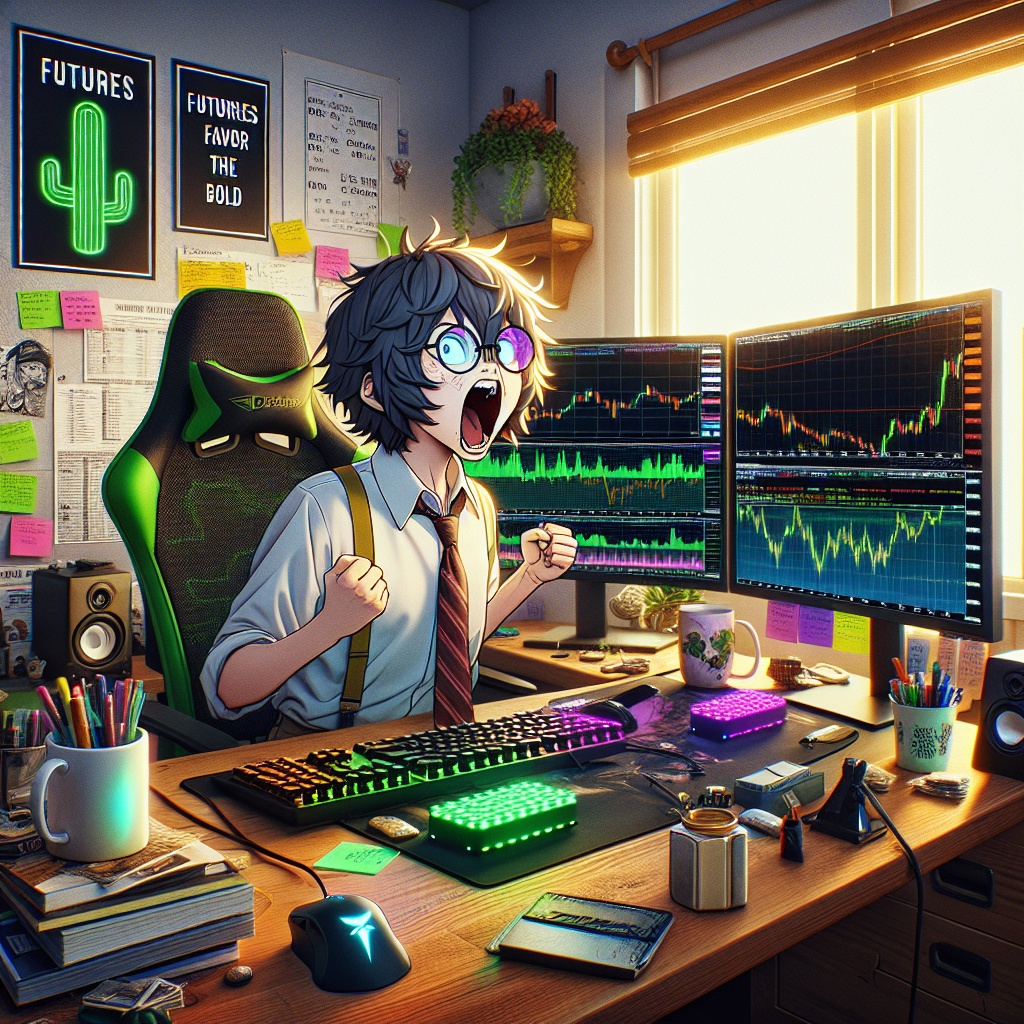CFD Vs Futures Full Breakdown For New Traders

Entering the world of trading for the first time can feel overwhelming. With so many options and technical terms thrown around, new traders need clarity on the differences between popular products like CFDs and futures. Understanding cfd vs futures is crucial for anyone hoping to build a successful trading foundation. Both instruments offer the potential for profit and risk, but they work differently, and knowing these details can make or break your first trades. Trading is not just about predicting which direction prices might go in the market. Picking the right product that matches your goals, risk tolerance, and investing style is just as important. Some traders are drawn by the flexibility of CFDs, while others swear by the structure of futures contracts. The decision is not a small one. It can impact your strategy, costs, and how you manage risk over time. Whether you are exploring starting with low minimums in trading accounts for the first time or want to understand which product is best for rapid news-driven moves, grasping these concepts will serve you well.
Throughout this breakdown, you will learn what is cfds, how to trade cfds, the differences between a cfd futures contract and a traditional futures agreement, plus the situations where each shines. With new regulations, innovations, and platforms emerging, staying informed is a must.
What Are CFDs?
CFDs have become especially popular because they offer a straightforward entry point for individuals with smaller capital. Unlike traditional investing, you don’t need to buy a full share or asset. Instead, you trade based on the asset’s price changes, often with the advantage of leverage. However, this ease of access and flexibility comes with its own set of risks, which every trader needs to understand. It’s also important to note that CFDs are prohibited in some regions and have unique regulations in others.
CFD Trading Meaning
The cfd trading meaning centers on speculation and leverage. Traders use CFDs to bet on the direction of an asset’s price. If you think the price will rise, you take a "long" position. If you believe the price will drop, you "short" the CFD instead. This mechanism is different from traditional asset ownership because you never actually possess the underlying security. Your focus is only on price movement, and your profit or loss is calculated accordingly.
What Is a CFD Trading Account
A CFD trading account is your gateway to accessing CFD products. It’s similar to a brokerage account, but it’s specifically designed for trading CFDs. To open one, you register with a provider offering CFD instruments and deposit funds as margin. This account is where you execute trades, observe market movements, and manage your exposure. Most CFD trading accounts support advanced analytical tools, customizable charting, and simulation features.
How to Trade CFDs Step by Step
Trading CFDs is appealing because of the structure and speed, but getting started in the right way can help prevent common errors. To help you make your first CFD trade, here’s a step-by-step guide covering everything from broker selection to trade closure.
Choose a Reliable CFD Broker
Your experience in trading CFDs heavily relies on the broker you pick. Not every broker is created equal. Choosing an established, regulated broker ensures you will have fair market access, competitive spreads, reliable order execution, and clear fee structures. Research broker reviews and regulatory standing to ensure your chosen platform is reputable. Try to avoid unregulated brokers, which might lead to unfair practices or platform instability.
Open and Fund Your CFD Trading Account
Once you’ve selected a broker, opening your cfd trading account involves completing KYC (Know Your Customer) steps, verifying your identity, and submitting some financial details. This process ensures your account is secure and complies with regulations. After approval, you can fund your account, typically via bank transfer, credit card, or various e-payment options.
Select the Asset You Want to Trade
With your account funded, you can browse through available markets. CFDs are offered for stocks, indices, commodities like oil or gold, and even cryptocurrencies in some regions. The best strategy is picking an asset class you understand or are willing to research closely, as price moves can be volatile and significantly affected by news or economic data.
Decide Whether to Go Long or Short
Once you’ve picked your asset, you need to decide on your trading direction. If you expect the price to rise, you “go long” or buy the CFD. If you expect a fall, you “go short” or sell the contract. This ability to quickly profit from both up and down markets is a central appeal of CFD products.
Set Your Leverage and Position Size
Before finalizing the trade, you choose your position size and adjust the cfd leverage. Leverage multiplies your exposure without requiring a massive cash deposit. For example, with 10:1 leverage, a $1,000 position only needs $100 margin up front.
Place Your Trade and Monitor It
After your settings are in place, submit your trade. Most platforms allow real-time position management, letting you track your open P&L, set alerts, or adjust stops and limits. Volatile markets can move quickly, so staying aware and ready to react is key, especially with leveraged products.
Close the Position and Review Results
When you’re ready to exit, close your CFD position to realize your profit or loss. Always review your trades: what went well, what you could do differently, and how fees or slippage affected results. Keeping a trade journal can accelerate your growth and help spot patterns in your performance.
CFD vs Futures Contract: How Do They Compare?
CFD contracts are agreements between you and your broker. You do not participate on a central exchange. This structure allows for flexible contract sizes, making it easier for new traders to start with smaller trades. The entry and exit pricing are often streamlined, and you can use fractional position sizes. On the other hand, futures contracts are standardized agreements traded on regulated exchanges. These contracts have set sizes, expiration dates, and are settled daily through a process called “marking to market.”
A major difference between futures vs cfd is how margin and leverage work. With CFDs, brokers often offer higher leverage, which means you can trade with a relatively low upfront deposit. This makes them accessible to retail traders who do not want to tie up a lot of capital. Futures, while also offering significant leverage, have minimum margin requirements set by exchanges and often require more up-front funding.
How a CFD Futures Contract Works
Let’s break it down. Imagine you want to gain exposure to oil futures without opening an account at a futures exchange or committing to a large contract size. With a CFD futures contract, your broker offers you a CFD based on the live price of the oil futures contract. You can buy or sell this CFD just like any other, going long if you expect a rise or short if you see a decline.
Key Features of a CFD Contract
CFD Contract Explained
A CFD contract allows you to profit from price movements without the need for ownership of the underlying asset. The basic principle behind a cfd contract is simple: you agree to pay (or receive) the difference in price of an asset from the contract’s open to close. There is no physical delivery, only a financial settlement.
For example, if you open a long CFD on 100 shares of a stock at $10, and the stock rises to $12, you gain $200, minus any applicable spread or fees. If the price falls, you incur a loss. This cash-settlement system means you can access global assets at a fraction of the traditional cost.
CFD Trading Example
To see how a CFD works, let’s walk through a classic cfd trading example. Assume you believe that shares of a tech company will rise after a strong earnings report. The current share price is $50. Using a CFD, you decide to buy 200 shares. The broker requires a 10% margin, so you only provide $1,000 to control a $10,000 position.
A week later, the company’s shares climb to $52. You close your position, realizing a gain of $2 per share, or $400 in total. If the price had dropped to $48, your loss would have also been $400, even though you only put up $1,000 in margin. This magnifying effect is cfd leverage in action.

Futures vs CFD in Currency Markets
How to Trade Currency Futures
Currency trading futures, also known as forex futures, are standardized contracts to buy or sell a currency at a defined date and price. These contracts are traded on exchanges like the CME and are settled daily, meaning profits and losses are transferred at the end of each trading day.
How to Trade Currency CFDs
Currency CFDs operate differently. Instead of exchanging contracts on an exchange, you trade directly with your broker using a cfd contract that mirrors the forex market’s price. You choose your position size, apply leverage, and open a trade in the direction you expect. There are no expiration dates, and you can hold trades for any period, provided you can meet margin requirements and cover any daily funding charges.
Leverage and Benefits of CFDs
CFD Leverage: Risks And Rewards
One of the most powerful aspects of CFD trading is leverage. With leverage, you can control a large position using a relatively small amount of capital. For example, 10:1 leverage allows you to open a $10,000 position with only $1,000. This can amplify your profits significantly if your trades go in the right direction.
CFD Benefits for New Traders
CFDs hold several clear cfd benefits for beginners. Accessibility is a major point. You do not need thousands of dollars to start, and you can trade partial shares or micro lots. This makes it easier to build experience and confidence before scaling up.
Flexibility also shines. You can go long or short on almost any asset, allowing for strategies that profit from both rising and falling markets. The wide range of available markets makes diversification simple for small accounts. Most brokers provide advanced analytic tools, demo accounts, and streamlined onboarding processes.
There’s also no set expiration date with most CFDs. You decide how long to hold your position, whether you want to trade for minutes or weeks. This contrasts with futures, where contracts must be settled or rolled over.
Are CFDs Banned in the US?
A common question among global traders is whether they can access CFDs while based in the United States. The simple answer is yes, CFDs are banned in the US for retail traders. The main reason for this restriction is the regulatory stance taken by the Securities and Exchange Commission (SEC) and the Commodity Futures Trading Commission (CFTC), both of which aim to protect individuals from significant financial risk.
Risks Every CFD Trader Should Know
Trading CFDs can involve high returns, but it comes with serious risks every new trader should realize before committing real money. The easy access and low capital requirements mean it’s possible to lose more than you initially invested very quickly. High cfd leverage is the main accelerator of profits and losses alike. Markets can move fast, and if your chosen asset’s price moves against you, losses are magnified. This can result in a margin call, requiring you to deposit additional funds or have your position closed at a loss.
Another risk is counterparty exposure. Because CFDs are traded directly with your broker, not on an exchange, you rely entirely on your broker to honor trades and withdrawals. Not all brokers are regulated or financially secure, which exposes you to additional danger if the firm fails.
Common Mistakes New Traders Make With CFDs
Many new traders are drawn to CFDs for their accessibility and fast potential returns. However, without the right knowledge and discipline, common mistakes can hurt both your confidence and your wallet.
One key mistake is trading without a solid plan. Jumping into trades on impulse, or following social media chatter, rarely ends well. Dedicated traders build a clear plan that defines goals, entry and exit criteria, position sizes, and risk limits. Sticking to your plan, even when the market moves quickly, protects your account.
Overusing leverage is another trap. Because cfd leverage multiplies both wins and losses, even small unfavorable moves can lead to margin calls or complete losses. Starting with lower leverage and always using stop-loss orders helps preserve capital while learning.
Ignoring fees and overnight charges can chip away at profits unnoticed. If you keep positions open for more than a day, be sure to understand your broker’s overnight funding policies. The cumulative effect of these charges can be significant for frequent traders.

Who Should Trade CFDs vs Futures?
Deciding between trading CFDs and futures depends on your goals, experience, capital, and preferred market style.
CFDs are a good match for those starting with lower amounts of capital or looking for flexibility in trade sizes. If you want to access global markets (stocks, currencies, indices) through a single account, or you prefer not to deal with complex expiry dates, CFDs provide that convenience. The absence of rigid contract sizes also means you can fine-tune your risk and scale your learning. Short-term traders, swing traders, and individuals looking to react quickly to breaking news often find CFDs to be a strong fit.
To compare supported assets and platforms, it’s smart to review different trading platforms for CFDs and futures to see which aligns with your trading approach.
Final Thoughts On CFDs and Futures
Choosing between CFDs and futures is a decision shaped by your personal trading experience, resources, and long-term goals. Each instrument offers unique benefits and comes with its own set of risks that every trader must understand before diving in. CFDs open the door for those with less capital or a desire for flexibility, letting you tailor trades to your needs and manage risk on a more granular scale. They blend low entry points with vast market access, making them a favorite for individual traders looking to grow and adapt quickly.
The right choice depends on your story as a trader. Assess your objectives, comfort with leverage, and appetite for risk. Developing a trading strategy that fits your chosen vehicle will set you up for success, whether your path leads you to CFDs, futures, or a combination. Use education, technology, and sound risk management as your foundation. To stay ahead and continually improve your trading practice, consider exploring the in-depth resources available for dedicated traders to sharpen your skills for the road ahead.



